This question derived from previous question and answer. You can found the link here: Haskell :: Recursion in Recursion for Loop in Loop (Part 1)
The question were answered, I can say super amazing with nice explanation for future reference. Credit to @user2407038 for his amazing skills. However, something interesting to ponder with recursion with more than two partition. To make it clear I've changed the data a little bit for simplicity. Here how it looks:
Previously, the 2 red dots were generated by finding (min x, min y) and (max x, max y). To generate 4 red dots (min x, min y) (max x, min y) (min x, max y) (max x, max y) partition4 should take into consideration. Visually it looks like this:
Considering the max members for each group is 3, group 1 and group 4 exceed the number. A new group should be created based on these group. However, the trickier part is that this group will not compute the distance with previous red dots:
The edited code for previous question:
data Point = Point { ptX :: Double, ptY :: Double }
data Cluster = Cluster { clusterPts :: [Point] }
minMaxPoints :: [Point] -> (Point, Point)
minMaxPoints ps =
(Point minX minY
,Point maxX maxY)
where minX = minimum $ map ptX ps
maxX = maximum $ map ptX ps
minY = minimum $ map ptY ps
maxY = maximum $ map ptY ps
main = do
let pointDistance :: Point -> Point -> Double
pointDistance (Point x1 y1) (Point x2 y2) = sqrt $ (x1-x2)^2 + (y1-y2)^2
cluster1 :: [Point] -> [Cluster]
cluster1 ps =
let (mn, mx) = minMaxPoints ps
(psmn, psmx) = partition (\p -> pointDistance mn p < pointDistance mx p) ps
in [ Cluster psmn, Cluster psmx ]
cluster :: [Point] -> [Cluster]
cluster ps =
cluster1 ps >>= \cl@(Cluster c) ->
if length c > 5
then cluster c
else [cl]
testPts :: [Point]
testPts = map (uncurry Point)
[ (1,0), (2,1), (0,2)
, (5,2), (4,3), (4,4)
, (8,2), (9,3), (10,2)
, (11,4), (12,3), (13,3) ]
main = mapM (map (\p -> (ptX p, ptY p)) . clusterPts) $ cluster testPts
print main
I've found it when the length c changed the answer as not as expected it should be. Perhaps I've edited it wrongly (Sigh).
Still figuring how to fit in PartitionN code for partitioning into N groups as suggested.


